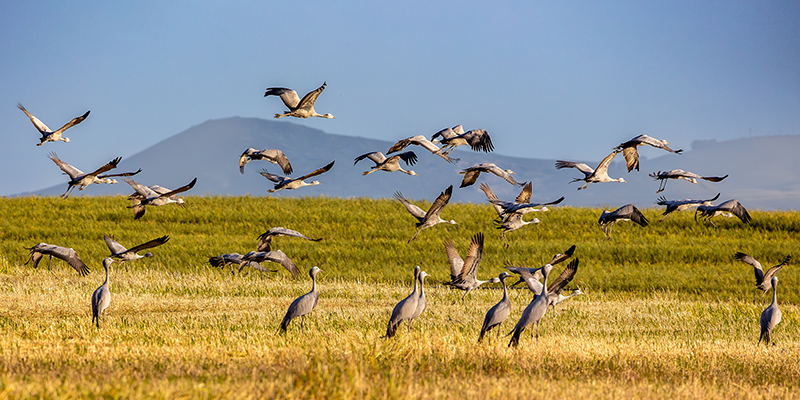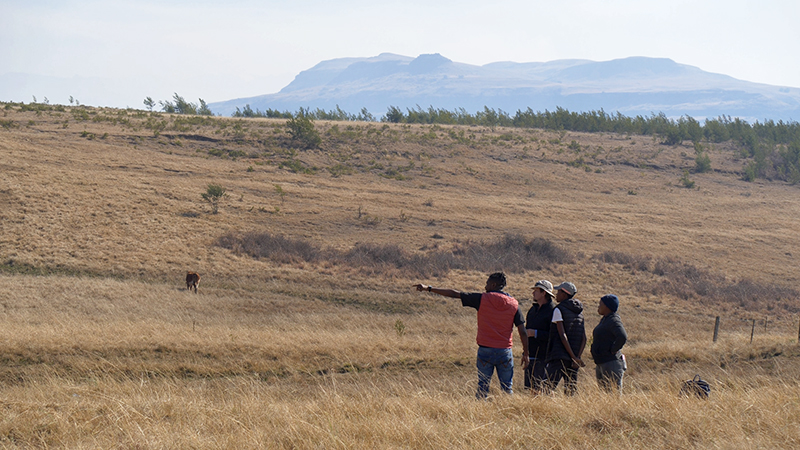
CONTACT: Jodi Legge, Director of External Affairs, 608-356-9462, ext. 120
Addresses Greenhouse Gas Emissions to Protect Habitat and Farmers in South Africa
Aug. 13, 2024 (South Africa) – As part of the long-term commitment to protect threatened grassland and wetland crane habitat in the Drakensberg region of South Africa, the International Crane Foundation – in partnership with Endangered Wildlife Trust – announces registration in one of only six registered carbon offsetting projects in the world using Voluntary Carbon Market Methodology – and covering the widest geographical footprint in the country.
Project developers must first apply for registration in the Voluntary Carbon Market through VERRA, the group that sets the world’s leading standards for climate action and environmental conservation. The partnership is organized through WeAct, an Australian company that provides expertise on carbon project development and carbon trading operations globally.
Carbon offsetting is considered a sustainable financing option by providing investments that reduce or remove emissions, improve livelihoods, and protect the environment. Carbon credits are sold on the market with revenue returned to landowners. Landowners are rewarded financially as they implement sustainable and improved land management practices that contribute to a healthier ecosystem, are friendly to cranes, and promote greater biodiversity.
The International Crane Foundation has worked in the Drakensberg region for more than 15 years. Home to three species of threatened cranes – Wattled, Blue, and Grey Crowned Cranes – this region’s ecosystem has been at risk from mining, infrastructure development, invasive species, uncontrolled fire, and agricultural expansion. These factors have reduced habitat for cranes and other species, and pose significant challenges to landowners, threatening the livelihoods of thousands of people who live and work in this region.
“We know these are complex problems, and this requires innovative solutions. Exploration of the carbon trading market has been one of our key strategies to reduce greenhouse gas emissions through carbon sequestration, to improve the state of these fragile habitats.”
Pieter Both, Carbon and Sustainable Agriculture Project Manager
Botha said the cost associated with the removal of greenhouse gas emissions to improve the soil is expensive and landowners cannot finance it on their own. This project addresses that financial burden. Removing CO2 from the atmosphere is a cheaper alternative than dealing with the consequences of global warming.
The Drakensberg project covers 90,000 hectares (approximately 222,000 acres). Almost 88,500 hectares is managed by the Foundation and Trust as a Carbon Management Entity. The Entity covers several critical areas through biodiversity stewardship agreements with landowners.
“Carbon trading is not frequently discussed among farmers as it is not part of their daily production cycle on the farm,” said Botha. “For many landowners, this was a foreign idea, and careful negotiation and education is required to explain the complexities of the project. It takes a long time to engage with landowners, explain the benefits of participating in the project, and get them to commit to an agreement.”

Farmers are custodians of large tracts of land, which is also home to many diverse species. The Foundation understands that farming has many challenges and no state assistance or subsidies are available in South Africa. This project aims to assist farmers by offsetting costs that come with conservation, creating an enabling environment for proactive conservation.
The project implemented a four-year cycle of carbon credit verification and issuance, with a goal to ensure a 30-year commitment to the project. Anticipated revenue is substantive.
“We believe this approach will mitigate the effects of global warming while creating resilient habitats for our crane population,” said Botha. “This pioneering approach will result in increased carbon in the soil, while providing relief to our resilient farmers to protect their livelihoods and create conservationists at the same time.”
